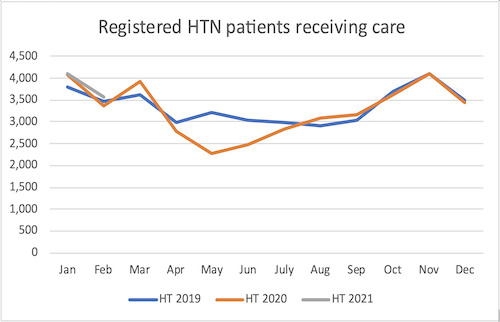Noncommunicable diseases (NCDs), primarily cardiovascular diseases, cancers, diabetes and chronic lung diseases, are the leading killers accounting for 74% of deaths in Thailand[1]. Prevention and control of NCDs is one of the six priorities under the WHO’s Country Cooperation Strategy with the Royal Thai Government. WHO catalyzed establishing a Strategic Technical Advisory Group on Hypertension and has raised the priority of hypertension control among the health policy makers. Working closely with key stakeholders[2], WHO has helped to strengthen hypertension care in Thailand by ways of improving treatment practices, quality and use of data, capacity building and operations research.
Pakkred is a densely populated and semi-urban district near Bangkok. 18.2% of the population is over 60 years old. Most older individuals have pre-existing chronic NCDs that require ongoing management. In early 2020, when COVID-19 was spreading rapidly, public health systems faced the dual challenge of containing the outbreak while protecting health care workers (HCW) and maintaining routine services for hypertension, diabetes, and other chronic NCDs. Routine services for NCDs were affected, and patients living with NCDs, especially the elderly, were unable or reluctant to visit health facilities for routine care.
The health leadership of Pakkred Hospital prioritized maintaining essential services for patients with chronic diseases. Several adaptations in delivery of NCD services including decentralized care from the hospital to the network of community health centers (CHCs), home blood pressure monitoring by Community Health Volunteers (CHVs), facility infrastructure changes to reduce COVID-19 exposure risk for patients and health staff, fast-track system for patients visiting health facilities, telemedicine to facilitate online consultation between HCWs.
Moreover, the LINE application was used for 24/7 communication between doctors, nurses, CHVs and home health care teams. A secure Facebook page was created for patient inquiries and to facilitate patient follow-up. Also, innovative ways to deliver medicines to patients were adopted, for example: pick-up of medications at district hospital and HPHs by healthier, younger relatives; a drive through facility at district hospital providing prescribed medications from a window; medication delivery through postal service by hospital staff; medication delivery by CHVs traveling via hospital van or motorcycle taxi.
Despite an initial decrease in the number of hospital visits, hypertension control rates were maintained through the COVID-19 epidemic. By September 2020, over 3000 patients had received care in hospital outpatient departments, a number similar to the same period in 2019. By September 2020, the hypertension control rate was 67% (3944/5881), compared to 64% (3838/6055) in September 2019. The fast-track system cut down NCD service times by 1-2 hours. No HCW and no NCD patient was diagnosed with COVID-19. Qualitative data revealed high overall patient satisfaction with the new interventions.
Figure 1- Registered hypertension patients on treatment and visiting OPD

The Pakkred initiative was part of a larger effort by the Thai MOPH to establish “new normal” health services designed to provide essential services while protecting staff and patients – during this and future epidemics.
[1] World Health Organization. Thailand Noncommunicable Diseases (NCD) Country Profiles, 2018, available at: https://www.who.int/nmh/countries/tha_en.pdf?ua=1, accessed on 15 April 2021.
[2] Stakeholders include the Field Epidemiology Programme, Thai hypertension Society, Chiang Mai University and Provincial health offices, Centers for Disease Control and Prevention, and Resolve to Save Lives.
Photo caption: Field investigator explaining 24-hour urine collection to a survey respondent.
Photo credit: Payong Khunsaard

